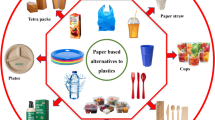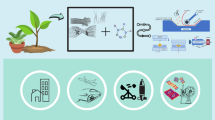Abstract
Interior grade particleboard prepared with tannin adhesives to which no aldehyde hardener was added were prepared. The hardening of the tannin adhesive was induced by the reaction of autocondensation tannins undergo when catalyzed by a lignocellulosic substrate or by a weak Lewis acid as alkali dissolved silica. The more alkaline the tannin extract solution the higher the ceiling internal bond strength that the particleboard bonded with it can reach. Differences between four commercial tannins are discussed. Pecan nut tannin and pine tannin need only lignocellulosic induced autocondensation to give excellent interior grade particleboard. Slower reacting tannins such as mimosa need instead both the catalytic effect of the substrate as well as that of a weak Lewis acid such as silica. Only pecan nut tannin appears at this stage to be able to give boards of acceptable dry internal bond strength at industrially significant pressing times.
Zusammenfassung
Spanplatten für die Innenverwendung wurden mit Tanninklebern hergestellt ohne Zugabe von Aldehyden als Härter. Die Härtung der Tannine erfolgt durch Autokondensation. Diese wird katalysiert durch ein lignocellulosisches Material oder eine schwache Lewis-Säure wie in Alkali gelöster Kieselsäure. Je alkalischer die Tanninlösung ist, desto höher ist die Querzugfestigkeit, die erreicht werden kann. Unterschiede zwischen vier kommerziellen Tanninen werden diskutiert. Tannine aus Hickorynuß und Kiefern können schon mit Lignocellulosen zur Autokondensation gebracht werden und eignen sich für hochgradige Spannplatten zur Innenverwendung. Langsamer ragierende Tannine aus Mimosa-Arten benötigen außer diesem Substrat noch eine schwache Lewis-Säure wie z.B. Kieselsäure. Zur Zeit scheint aber nur Hickory-Tannin geeignet zu sein, Spanplatten mit ausreichender Querzugfestigkeit innerhalb industriell vertretbarer Preßzeiten herzustellen.
Similar content being viewed by others
5 References
DIN 68763. 1982: Spanplatten: Flachpressplatten fur das Bauwesen. Beuth Verlag, Berlin
DIN EN 120. 1984: Spanplatten — Bestimmung des Formaldehydgehalts — Extraktionsverfahren genannt Perforatormethode. Beuth Verlag, Berlin
Meikleham, N.;Pizzi, A.;Stephanou, A. 1994: Induced Accelerated Autocondensation of Polyflavonoid Tannins for Phenolic Polycondensates. Part 1: C13 NMR, Si29 NMR, X-Ray and Polarimetry Studies and Mechanism. J. Appl. Polymer Sci., 54: 1827–1845
Pizzi, A. 1983: Wood Adhesives Chemistry and Technology. Marcel Dekker, New York
Pizzi, A. 1994: Advanced Wood Adhesives Technology. Marcel Dekker, New York
Pizzi, A.;Meikleham, N.;Stephanou, A. 1995: Induced Accelerated Autocondensation of Polyflavonoid Tannins for Phenolic Polycondensates. Part 2: Cellulose Effect and Application. J. Appl. Polymer Sci., 55: 929–933
Pizzi, A.;Stephanou, A. 1993a: Comparative and Differential Behaviour of Pine vs. Pecan Nut Tannin Adhesives for Particleboard. Holzforschung Holzverwertung 45(2): 30–33
Pizzi, A.;Stephanou, A. 1993b: A Comperative C13 NMR Study of Polyflavonoid Tannin Extracts for Phenolic Polycondensates. J. Appl. Polymer Sci. 50: 2105–2113
Pizzi, A.;Stephanou, A. 1994c: A C13 NMR Study of Polyflavonoid Tannin Adhesive Intermediates. Part 1: Noncolloidal Performance Determining Rearrangements. J. Appl. Polymer Sci., 51: 2109–2124
South African Bureau of Standards, SABS 1300–1980. Specification for Particleboard, Exterior and Flooring type (1980). 34pp
Author information
Authors and Affiliations
Rights and permissions
About this article
Cite this article
Pizzi, A., Meikleham, N., Dombo, B. et al. Autocondensation-based, zero-emission, tannin adhesives for particleboard. Holz als Roh-und Werkstoff 53, 201–204 (1995). https://doi.org/10.1007/BF02716424
Issue Date:
DOI: https://doi.org/10.1007/BF02716424




